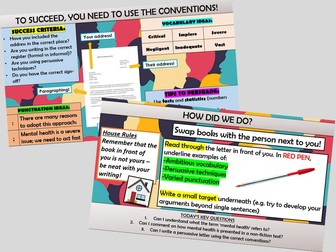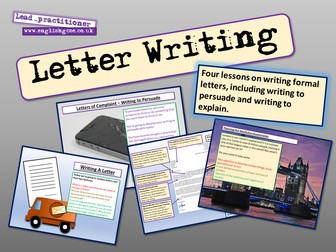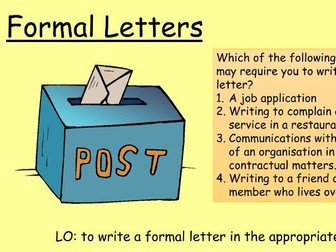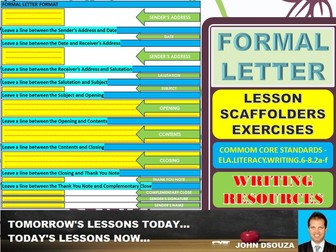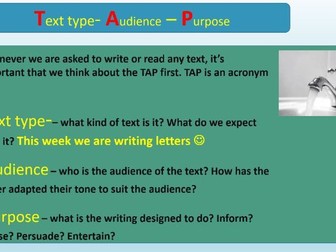
Persuasive/Letter Transactional Writing
-Theme of mental health
-Extract analysis followed by transactional writing
-GCSE English Language Paper 2 practise

Informal Letter Writing!
This stimulating and informative lesson develops students’ skill in creating informal letters that precisely meet the content, language and structural features of the form. In particular, they gain an in-depth understanding of how informal letters should be set out on the page, what information should be included within them, and what style they should be written in, in order to meet form, audience and purpose.
Students follow a clear and logical learning journey, in which they:
-Understand why letter writing is still important in the present day;
-Unjumble a model example of an informal letter in order to establish its structure;
-Work collaboratively to identify and analyse the content and language features in further model examples of informal letters;
-Create a success criteria for effective informal letters (although a ready-made success criteria is included);
-Write their own informal letters, using a structure strip and helpsheet (if needed) and the techniques that they have learnt;
-Peer/self-assess their writing attempts.
There are enough resources here really for two lessons, including:
-Visually engaging whole-lesson PowerPoint;
-Informal letters x 3 (based on The Simpsons, Batman, and Harry Potter characters)
-Informal letters structure strip;
-Informal letters helpsheet;
-Step-by-step lesson plan.
All images are licensed for commercial use, and are cited on the final page of the slide.

Persuasive letter writing example
I couldn't find a text on line which provided the example of what I was looking for in a model persuasive letter. So I wrote one (and wish that i had done earlier as it was quicker)
This is a letter to the head teacher which tries to persuade them to get rid of school uniform.
It can be used as a model text to look at with the children to identify features and language.
It could be used a starting letter to be up-leveled and improved
We used it as the 'Imitate' text at the beginning of a T4W cycle
Hope you find it useful and it saves you some time.

Titanic Letter Writing
This download includes:
Two week planning for Titanic letter writing
Letter examples
PowerPoint which follows planning
Examples of real letters from the time
Postcard templates for publishing
My Year 6’s really enjoyed this writing task and produced some fantastic work!
Teaching the Titanic? Check out our other Titanic writing resources!
undefined
Bundle

Letter Writing
Four letter writing lessons that include:
Assessment planning lesson - formal letter
Writing formal letters lesson
Writing letters of complaint (Writing to persuade)
KS3 writing a letter lesson
Check out our English Shop for loads more free and inexpensive KS3, KS4, KS5, Literacy and whole school resources.
AQA English Language Paper 1 and Paper 2 Knowledge Organisers
AQA English Language Paper 1 Section A package
AQA English Language Paper 1 Sections A and B package
AQA English Language Paper 1 package
AQA English Language Paper 2 Question 5 package
AQA English Language Paper 1 Question 5 package
AQA English Language Paper 2 Section A package
AQA English Language and English Literature revision package
An Inspector Calls whole scheme package
An Inspector Calls revision package
Macbeth whole scheme package
Macbeth revision package
A Christmas Carol whole scheme package
A Christmas Carol revision package
Jekyll and Hyde whole scheme package
Jekyll and Hyde revision package
Romeo and Juliet whole scheme package
Power and Conflict poetry comparing poems package
Power and Conflict poetry whole scheme package
Love and Relationships poetry whole scheme package
Unseen Poetry whole scheme package
Or check out some Citizenship GCSE, RE, PSHE + RSE resources at EC Resources

Formal Letter Writing for GCSE
Aimed at middle-upper ability GCSE groups, this PowerPoint teaches the layout and language of a formal letter. It is oriented towards AQA 8700/2/Question 5 but could be adapted for other boards.
In order, the PowerPoint contents are:
A multiple-choice entry task
AQA advice on features of format
A sample AQA-style question. Students identify PAF and reflect on the importance of being mindful of PAF in relation to Question 5. Extension task included.
The layout of a formal letter, which students copy. Extension questions included.
Notes regarding the formal greeting and formal sign-off
A re-cap on the features of formal and informal language. Students cut the features out, organise them under two headings and stick them into their books.
An example response to the given question. Students read and identify different features (differentiated)
An opportunity for independent writing, with success criteria provided.
Peer assessment and self-reflection.
These files were last saved in Office 2010.

English Language: Letter Writing
This lesson has been designed for anyone studying GCSE English language for AQA. The lesson goes through how to write a letter, key techniques and how to respond to an exam question.
If you liked this lesson then please check out our shop for more lessons and resources.

FORMAL LETTER WRITING: LESSON AND RESOURCES
A unit lesson plan with 6 sessions on teaching and learning resources of formal letter writing based on New Bloom’s Taxonomy.
After completing this unit students will be able to:
SESSION 1 - REMEMBERING: Recognise and retrieve the key elements of a formal letter.
SESSION 2 - UNDERSTANDING: Interpret and classify the authorial techniques in a formal letter.
SESSION 3 - APPLYING: Implement and execute formal letter writing techniques.
SESSION 4 - ANALYSING: Explore and demonstrate the knowledge of formal letters in writing.
SESSION 5 - EVALUATING: Check and critique a sample formal letter.
SESSION 6 - CREATING: Compose and produce the final formal letter.
This download includes:
FLIPPED LESSON: Video - Know the Rules of Formal Letter Writing
LESSON STARTER: List the differences between Formal and Informal Letters – use VENN DIAGRAM to spot the similarities as well.
SESSION 1: REMEMBERING - RECOGNISE-RETRIEVE
EXERCISE 1: Find, list and label the structure and features of a formal letter.
Scaffolding Notes 1: Structure and Features of Formal Letter
SESSION 2: UNDERSTANDING - INTERPRET-CLASSIFY
EXERCISE 2: Explain the use of the language, the vocabulary and the impact of it in a formal letter.
Scaffolding Notes 2: Impact of Language and Vocabulary in a Formal Letter
Scaffolding Notes 3: Author’s use of Language in a Formal Letter
SESSION 3: APPLYING - IMPLEMENT-EXECUTE
EXERCISE 3: Use a planning frame to arrange a sample formal letter.
Scaffolding Notes 4: Planning Frame of a Formal Letter
SESSION 4: ANALYSING - EXPLORE-DEMONSTRATE
EXERCISE 4: Use the template to organise a draft of a sample formal letter.
Scaffolding Notes 5: Formal Letter Template
SESSION 5: EVALUATING - CHECK-CRITIQUE
EXERCISE 5: Use the checklist and the rubric to evaluate each other’s work.
EXERCISE 6: Use the PQP and TAG technique to peer-review each other’s work with constructive feedback.
Scaffolding Notes 6: Formal Letter Checklist
Scaffolding Notes 7: PQP and TAG technique
SESSION 6: CREATING - COMPOSE-PRODUCE
EXERCISE 7: Integrate the feedback and write a formal letter.
Scaffolding Notes 8: Formal Letter Prompt
DIFFERENTIATION:
EXERCISE 8 - Write a letter to people unknown following the FORMAL LETTER FORMAT.
Scaffolding Notes 9: Formal Letter Rubrics
PLENARY:
EXERCISE 9 - Answer the given questions to demonstrate your knowledge of the formal letter on Kahoot.
HOME LEARNING:
EXERCISE 10: Use Letter Generator to write a letter to your Class Teacher telling him/her how you spent your holidays.
EXERCISE 11: Letters of Persuasion
EXERCISE 12: Letters of Request
EXERCISE 13: Letters of Complaints and Responses
EXERCISE 14: Letters of Social Business

Letter Writing
Discusses the difference between formal and informal letters and then how to write a formal letter with a writing exercise at the end. Follows the themes of heroes.

Writing a covering letter
Resource for English and PSHE; guides students in how to write a good covering letter to accompany a CV.
Sale

Letter writing
Introductory lesson to letter writing. Guide for formal and informal letter writing. Homework assignment also included

Letter Writing
This is an excellent resource for teaching students how to write an informal letter. The activity also assist students in developing paragraphs within a writing piece.

Letter Writing
A unit of work looking at formal letter writing. Children will learn to write a letter to their headteacher. Model text, worksheets and flipchart,

Formal Letter Writing!
This stimulating and informative lesson develops students’ skills in creating formal letters that precisely meet the content, language and structural features of the form. In particular, they gain an in-depth understanding of how formal letters should be set out on the page, what information should be included within them, and what style they should be written in, in order to meet form, audience and purpose.
Students follow a clear and logical learning journey, in which they:
-Understand when and where formal letters are an appropriate form of communication;
-Unjumble a model example of a formal letter in order to establish its structure;
-Work collaboratively to identify and analyse the content and language features in further model examples of formal letters;
-Create a success criteria for effective formal letters (although a ready-made success criteria is included);
-Write their own formal letters, using a structure strip and helpsheet (if needed) and the techniques that they have learnt;
-Peer/self-assess their writing attempts.
There are enough resources here really for two lessons, including:
-Visually engaging whole-lesson PowerPoint;
-Formal letters x 3 (a complaint, information about a school trip, and a covering letter for a job application)
-Formal letters structure strip;
-Formal letters helpsheet;
-Step-by-step lesson plan.
All images are licensed for commercial use, and are cited on the final page of the slide.

Letter Writing
In stage 3-4, students need to be familiar with writing both formal and informal letters. This resource can work as a sample to get started.

Writing A Formal Letter
Students look at letter writing features in terms of language, structure and layout and use their notes to write their own formal letter. This incredibly detailed lesson includes models, scaffolds, differentiated activities and helpful self-assessment success criteria to ensure all students succeed in creating a detailed and accurate formal letter. Useful for both KS3 and KS4 students and for AQA English Language Paper 2 Section B or Question 5. Fully differentiated throughout.

Letter writing
Job application letter
Help for street children letter
Letter to Council
Complaint letter for a faulty item
Letter for refund
Complaint letter to a restuarant about food poison
Letter to a friend advising how to prepare in the exam

